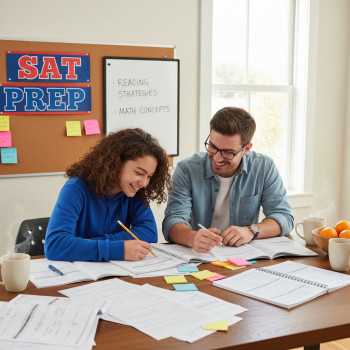Introduction: Why this comparison matters
If you or your child is navigating the college admissions maze, you’ve probably heard the question more than once: how do SAT scores compare to A-Levels or the International Baccalaureate (IB)? That question carries real weight. Admissions teams review a blend of academic credentials, and for international students—and even many U.S. students—understanding how standardized test scores like the SAT fit alongside diploma-based systems (A-Levels and IB) can make the difference between feeling lost and feeling confidently prepared.

Big picture: What admissions officers actually look for
Universities don’t view any single number in isolation. Whether an application carries SAT scores, A-Level grades, or IB scores, admissions officers want to see academic readiness, intellectual curiosity, and the context that makes each student unique. Think of SATs as one clear, comparable data point and A-Levels/IB as richer, curriculum-based narratives. When committees evaluate applications, they typically consider:
- Academic achievement (grades, diploma scores, course rigor)
- Standardized test performance (SAT or equivalent)
- Extracurricular activities, leadership, and impact
- Personal essays and recommendations
- Contextual factors—school type, country, access to resources
So the comparison isn’t about picking a winner. It’s about understanding what each credential communicates and how to present a coherent package that highlights a student’s strengths.
How the credentials differ—and what each reveals
SAT: a snapshot of transferable skills
The SAT measures reasoning and problem-solving in evidence-based reading, writing, and math. Because it’s a standardized exam, the SAT provides admissions teams with a consistent, easily comparable metric across educational systems. That makes it especially useful when applicants come from different countries, curricula, and grading scales.
Key strengths of the SAT:
- Comparability: Colleges can quickly benchmark applicants against a global pool.
- Portability: A single SAT score is recognized broadly by U.S. colleges (and many institutions abroad).
- Diagnostic detail: Score reports can show strengths and weaknesses (e.g., math vs. reading).
A-Levels: depth and specialization
A-Levels are subject-focused qualifications (often studied over two years) that let students specialize. Admissions officers interpret strong A-Level results as evidence of subject mastery and intellectual depth—particularly valuable for degree programs that demand deep foundational knowledge (e.g., engineering, physics, languages).
Key strengths of A-Levels:
- Subject expertise—students often study fewer subjects but at greater depth.
- Predictive of success in specialized degree programs.
- Clear, internationally recognized grading structure (A*–E).
IB: breadth plus the learner profile
The IB diploma emphasizes both breadth (six subject groups) and cross-disciplinary skills like research, critical thinking, and theory of knowledge. Universities often value IB students for their demonstrated ability to balance diverse subjects and undertake an extended project (the Extended Essay), which signals readiness for rigorous undergraduate study.
Key strengths of IB:
- Balanced academic profile across sciences, humanities, and languages.
- Holistic skills—research, reflection, and independent learning.
- Contextual indicators: the Extended Essay and Creativity, Activity, Service (CAS) illustrate initiative and time management.
Putting numbers side-by-side: interpretive frameworks
One common way to compare is via concordance and context. While there isn’t a direct one-to-one conversion that’s universally accepted between SAT scores and A-Level/IB grades, admissions offices use a combination of score ranges, percentiles, and local knowledge to interpret applications fairly. Colleges often publish the typical SAT ranges for admitted students and the average A-Level/IB profiles they accept. Below is a simple illustrative table—remember, this is a general guide, not an official conversion.
| Typical SAT Range | Rough IB Total (out of 45) | Typical A-Level Profile | Admissions Interpretation |
|---|---|---|---|
| 1500–1600 | 40–45 | A*A*A* to A*A*A | Highly competitive—likely to be in range for very selective programs. |
| 1350–1490 | 35–39 | A*A*A to A*AA | Strong applicants for selective universities and many competitive majors. |
| 1200–1340 | 30–34 | ABB to AAB | Solid candidates for many reputable institutions; program fit and essays matter. |
| 1000–1190 | 25–29 | BBC to BBB | Competitive for less selective schools and many regional colleges. |
| <1000 | <25 | <BBB | Many schools consider the full profile—supplemental materials and demonstrated fit can be decisive. |
Two important caveats: first, some institutions place more weight on one credential over another depending on country-specific admissions philosophies; second, range overlap is common—higher IB/A-Level results can offset average SATs and vice versa.
Real-world examples: how admissions teams blend credentials
Imagine three students applying to the same selective university:
- Alex from the UK: A-Level profile A*A*A in Math, Physics, and Further Math; no SAT submitted. The university sees deep subject expertise—excellent fit for engineering.
- Bina from India: IB diploma with a 41/45 and a strong Extended Essay in Economics; SAT 1460. The combination signals both breadth and strong standardized performance—Bina looks versatile and prepared.
- Chris from the U.S.: SAT 1520, APs in Calculus and Physics with 5s, high school GPA 3.9. Strong standardized score compensated for less specialized coursework; the essays and recommendations reinforce academic motivation.
In each case, admissions committees weigh the mix: subject mastery, standardized evidence, coursework rigor, and application narrative. The student who tells a coherent story—why their choices matter and how they’ll succeed in the chosen major—wins.
International context: why SATs can be useful for non-U.S. students
For students studying A-Levels or IB outside the U.S., submitting SAT scores can help in two ways:
- Standardized comparison: SATs give admissions officers a familiar scale to compare applicants from different grading systems.
- Demonstrated readiness: a strong SAT score reassures admissions teams about English-language reasoning and quantitative skills—especially useful if the local grading inflation/deflation is hard to interpret.
That said, many institutions are perfectly comfortable evaluating A-Level and IB credentials on their own. A smart strategy is to research target schools: some universities explicitly recommend submitting tests when applying from certain regions, while others consider them optional.
Navigating test-optional and test-flexible policies
The admissions landscape has shifted toward flexibility: many colleges have introduced test-optional, test-blind, or test-flexible policies. Here’s what that means in practice:
- Test-optional: You choose whether to submit SAT scores. Strong scores can bolster your application; weak scores can be left out.
- Test-blind: The institution does not consider SAT scores at all, even if submitted.
- Test-flexible: Colleges accept a range of standardized evidence—SAT, ACT, or other validated assessments in lieu of one another.
When a school is test-optional, the decision to submit an SAT score should hinge on whether the score strengthens your narrative. If your A-Levels or IB predicted/actual scores are exceptional and well-aligned to the intended major, you might not need the SAT. Conversely, a high SAT can provide an extra layer of assurance for admissions officers reviewing international grades.
Practical advice: choosing what to submit and how to present it
For students with strong A-Level/IB results
- Only submit SAT scores if they add something new—e.g., a high math score for STEM applications or a reading score that reinforces humanities preparedness.
- Use your personal statement to explain curriculum choices and any contextual challenges (e.g., reduced school resources or pandemic interruptions).
For students with mixed or lower diploma grades
- A strong SAT can be an equalizer—consider targeted SAT preparation to raise key section scores.
- Supplement with AP/IB Higher Level scores, if available, to demonstrate subject mastery.
For U.S. applicants with A-Levels or IB
- Explain your curriculum in the application so admissions officers understand rigor—A-Levels and IB are highly respected, but not every reader will know the details.
- Provide context: include grade descriptors, if allowed, and highlight coursework that aligns with your intended major.
How to prepare strategically: study plans and evidence of potential
Preparation should be smart, not frantic. Whether you’re leaning on SATs, A-Levels, IB, or a combination, focus on these priorities:
- Targeted practice: Use SAT official practice and high-quality materials to track progress and identify weak spots.
- Depth where it counts: For A-Levels/IB, prioritize mastery in the subjects most relevant to your intended major.
- Application storytelling: Use essays and recommendations to knit together your academic record and extracurricular life into a compelling narrative.
Many families find one-on-one tutoring extremely helpful here. Personalized tutoring—such as Sparkl’s 1-on-1 guidance—can create tailored study plans, provide expert tutors who understand how to position SAT scores alongside A-Levels/IB, and use AI-driven insights to target improvements efficiently. That approach helps students make measurable gains without burning out.
Sample study timeline
Below is a simple timeline that blends SAT prep with A-Level/IB study responsibilities over an academic year. Adjust timing to your exam dates and university deadlines.
| Months Before Applications | Focus | Actions |
|---|---|---|
| 12–9 months | Foundations | Build content knowledge for A-Levels/IB and begin light SAT practice; set target SAT score and draft study schedule. |
| 9–6 months | Skill-building | Increase SAT practice to weekly timed sections; deepen subject study for A-Levels/IB; begin college research. |
| 6–3 months | Intensive prep | Take full-length SATs under test conditions; revise A-Level/IB topics; draft and refine essays; seek tutoring where needed. |
| 3–0 months | Polish & submit | Finalize scores to submit; complete applications; gather recommendations; rest and finalize exam strategies. |
Personal stories: small changes, big impact
Students repeatedly tell us that a few targeted adjustments moved the needle more than months of unfocused studying. For example, fixing a recurring algebra weakness lifted one student’s SAT math score by 70 points after just six weeks—their improved score complemented strong A-Level sciences and secured them an interview offer from a competitive engineering program.
Another student combined a well-structured IB Extended Essay with a high SAT reading score to strengthen an application for a humanities major. The lesson? Use each credential to highlight complementary strengths.
Common myths and simple truths
- Myth: “You need perfect SATs to get into top colleges.” Truth: Top applicants are complex—perfect scores help, but context, essays, and fit matter hugely.
- Myth: “A-Levels/IB alone are enough everywhere.” Truth: Many U.S. institutions accept diploma-only applicants, but SAT scores can make international comparisons easier.
- Myth: “If my school is unknown, my SAT won’t matter.” Truth: SATs are especially useful when school records are hard to interpret—they provide a common baseline.
Checklist: what to do next (for students and parents)
- Research target colleges—note whether they are test-optional, test-blind, or require scores from international applicants.
- Decide whether submitting an SAT score strengthens your application based on your current A-Level/IB profile.
- Create a realistic study plan that balances diploma coursework with any required standardized test prep.
- Consider targeted help: 1-on-1 tutoring (for example, Sparkl’s personalized plans) can accelerate improvement and focus study time efficiently.
- Use admissions offices’ published admitted-student profiles (SAT ranges, IB/A-Level profiles) to set realistic targets.
- Prepare application narratives that link coursework, tests, and extracurriculars into a single, compelling story.

Final thoughts: build the strongest possible story
The short version: SAT scores, A-Levels, and IB scores each tell admissions committees different things. The SAT offers a reliable comparative measure across borders; A-Levels show focused mastery; IB signals breadth and independent learning. None of these alone guarantees admission—but together they form a fuller picture.
Families who succeed approach applications strategically: they know which credentials to emphasize, they prepare deliberately, and they craft a narrative that connects the dots. If the process feels overwhelming, personalized support—tailored study plans, expert tutors, and data-driven insights—can be exactly the boost a student needs. Services like Sparkl can help by offering 1-on-1 guidance, targeted curriculum alignment, and AI-informed progress tracking so students make efficient, targeted improvements.
Remember: admissions is not a single-number race. It’s a careful, human evaluation of fit, potential, and resilience. Aim for strong credentials, but don’t forget to tell your story. Your unique combination of tests, coursework, and lived experience is the real asset—use it wisely.
Resources to keep on hand as you plan
Keep a simple folder (digital or paper) with these items as you apply:
- Official SAT and diploma (A-Level/IB) score reports or predicted grades
- College-specific score ranges and application policy notes (test-optional/test-blind)
- Personal statement drafts and a timeline for revisions
- Contact info for recommenders and a plan to brief them
- A realistic study schedule and checkpoints for both SAT practice and diploma study
Closing encouragement
If you’re reading this as a student, know that admissions teams are looking for honest, committed learners—your curiosity and the way you show up matter as much as any test. If you’re a parent, your steady support and good information make a huge difference. Take incremental steps, celebrate small wins, and remember: whether through SATs, A-Levels, IB, or a thoughtful combination, you can build an application that truly represents who you are and what you can become.
Good luck—and when you need focused help, consider reaching out for tailored guidance that meets your unique needs.

















No Comments
Leave a comment Cancel